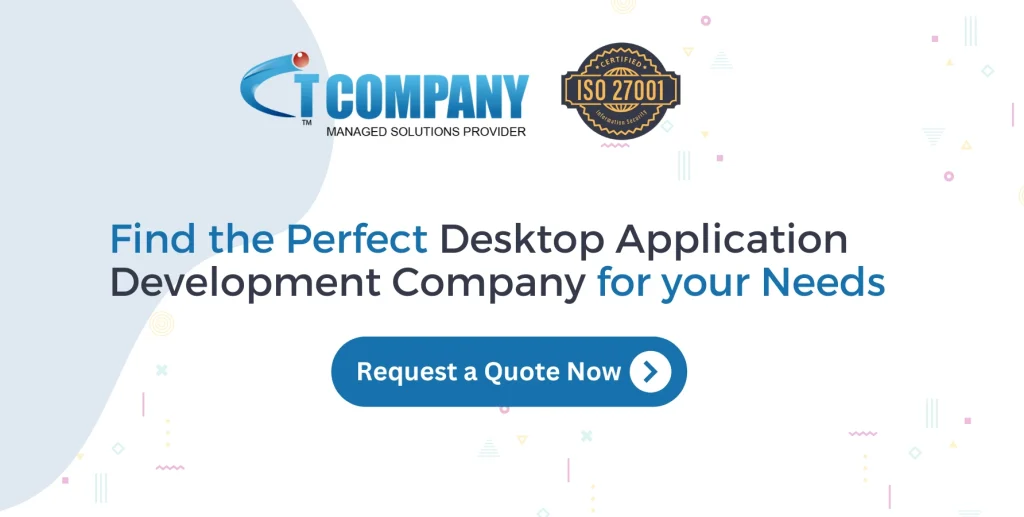
Desktop application development company specializes in creating software applications designed to run on desktop computers. These apps can server various purposes such as productivity, games and other business solutions. Apps are important for any business whether you are small business or large multinational corporations.
Choosing the right right development company is very important as they can understand your business requirements, navigation process and a solution to meet your vision.
Table of Contents
ToggleUnderstanding Your Needs
Before diving into the selection process, it’s essential to understand your specific needs. Ask yourself:
| Criteria | Description |
| Purpose of the Application | Define whether it will be for: – Internal Use: Tools for employees (e.g., HR systems). – Customer Interaction: Applications aimed at engaging customers (e.g., e-commerce platforms) – Both: Applications serving both internal and external users (e.g., CRM systems). |
| Target Audience | Identify your users: – Demographics: Age, location, profession. – User Needs: What problems are they trying to solve? – Technical Skill Level: Are they tech-savvy or novices? |
| Essential Features | Prioritize key functionalities: – User Interface: Intuitive design for ease of use. – Performance: Fast load times and smooth operation. – Security: Data protection measures and compliance. – Integration Capabilities: Ability to work with other systems and tools. |
Having a clear vision will streamline your search and help you communicate effectively with potential developers.
Researching Potential Companies
Once you have a grasp of your requirements, start researching potential desktop application development companies. Here are some effective strategies:
1. Online Search
Utilize search engines to find companies specializing in desktop application development. Look for firms with strong online presences, as this often indicates a commitment to quality.
2. Industry Directories
Consult industry-specific directories and platforms. These platforms offer reviews and ratings, helping you assess companies based on client feedback.
3. Networking
Leverage your professional network. Ask colleagues, industry peers, or business mentors for recommendations. Personal referrals can often lead to trustworthy partners.
4. Social Media and Forums
Explore social media platforms and developer forums to identify active companies in discussions about desktop applications. Engage with these communities to gather insights and experiences.
Evaluating Portfolios
Once you have a shortlist of potential companies, review their portfolios. A strong portfolio showcases a company’s capabilities and versatility. Consider the following:
- Diversity of Projects: Look for a variety of applications across different industries. This indicates adaptability and a broad skill set.
- Relevance: Assess whether they have experience with projects similar to yours in terms of complexity and features.
- Quality of Work: Evaluate the design and functionality of their applications. User experience should be a priority, reflecting a good understanding of best practices.
Assessing Expertise
Expertise is crucial when choosing a development partner. Here are key factors to consider:
1. Technology Stack
Different desktop applications require different technologies. Inquire about the technologies the company uses. Ensure they have experience with the tools best suited for your project.
2. Industry Knowledge
Firms with experience in your industry can provide valuable insights and solutions tailored to your specific challenges and requirements.
Reviewing Client Testimonials and Case Studies
Client testimonials and case studies offer a glimpse into a company’s reliability and performance. Look for:
- Success Stories: Checkout their demonstrated successful project deliveries, especially for clients with needs similar to yours, are often more trustworthy.
- Long-Term Relationships: A company that maintains long-term relationships with clients likely provides excellent service and support.
Reach out to previous clients if possible to gain firsthand insights into their experiences.
Understanding Communication and Collaboration
Effective communication is vital for a successful partnership. Assess the following aspects:
1. Response Time
Evaluate how quickly the company responds to inquiries. A prompt response often indicates good customer service.
2. Communication Channels
Determine the communication methods they prefer (email, phone, video calls) and ensure they align with your preferences.
3. Collaboration Tools
Inquire about the tools they use for project management and collaboration. Familiarity with tools can enhance workflow efficiency.
Assessing Support and Maintenance
Post-launch support is crucial for any desktop application. Discuss the following:
1. Maintenance Plans
Understand what maintenance services the company offers. Regular updates and bug fixes are essential for long-term application health.
2. Technical Support
Ensure they provide adequate technical support to resolve issues promptly. Inquire about their support hours and response times.
3. Scalability
Discuss how the company handles scalability. As your business grows, your application may require additional features or enhanced performance.
Budget Considerations
Cost is always a significant factor in decision-making. Consider the following:
1. Clear Pricing Structure
Ask for a detailed pricing structure that outlines costs for development, maintenance services, and any additional cost incurred.
2. Value for Money
While it’s essential to stick to your budget, don’t compromise on quality. A lower price may result in subpar work. Balance cost with the quality of service and expertise.
3. Payment Terms
Discuss payment terms and conditions upfront to avoid misunderstandings later on. Be clear about milestones and deliverables tied to payments.
Making the Final Decision
After thorough research and evaluations, it’s time to make your decision. Consider the following steps:
- Compare Options: Create a comparison chart of the top candidates based on expertise, portfolio, client feedback, and pricing.
- Follow Your Instincts: Sometimes, your gut feeling about a company can be a strong indicator of a good fit.
- Schedule a Meeting: Engage in a final meeting with your top choices to discuss your project in detail. This will also help you gauge their enthusiasm and understanding of your needs.
Conclusion

Choosing the right desktop application development company is crucial for the success of your project. By understanding your needs, conducting thorough research, evaluating expertise, and considering post-launch support, you can make an informed decision.
Remember, a strong partnership can lead to a successful application that meets your business goals and provides an exceptional user experience. Take your time, trust your instincts, and invest in a company that shares your vision.




